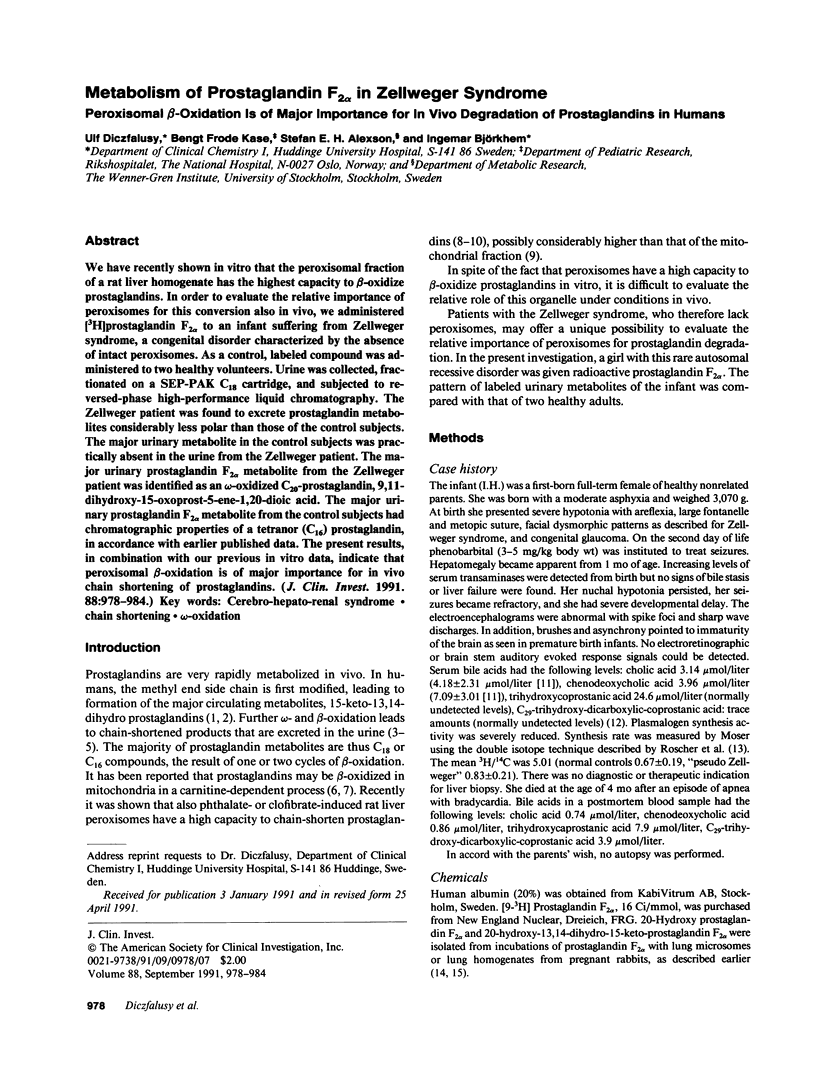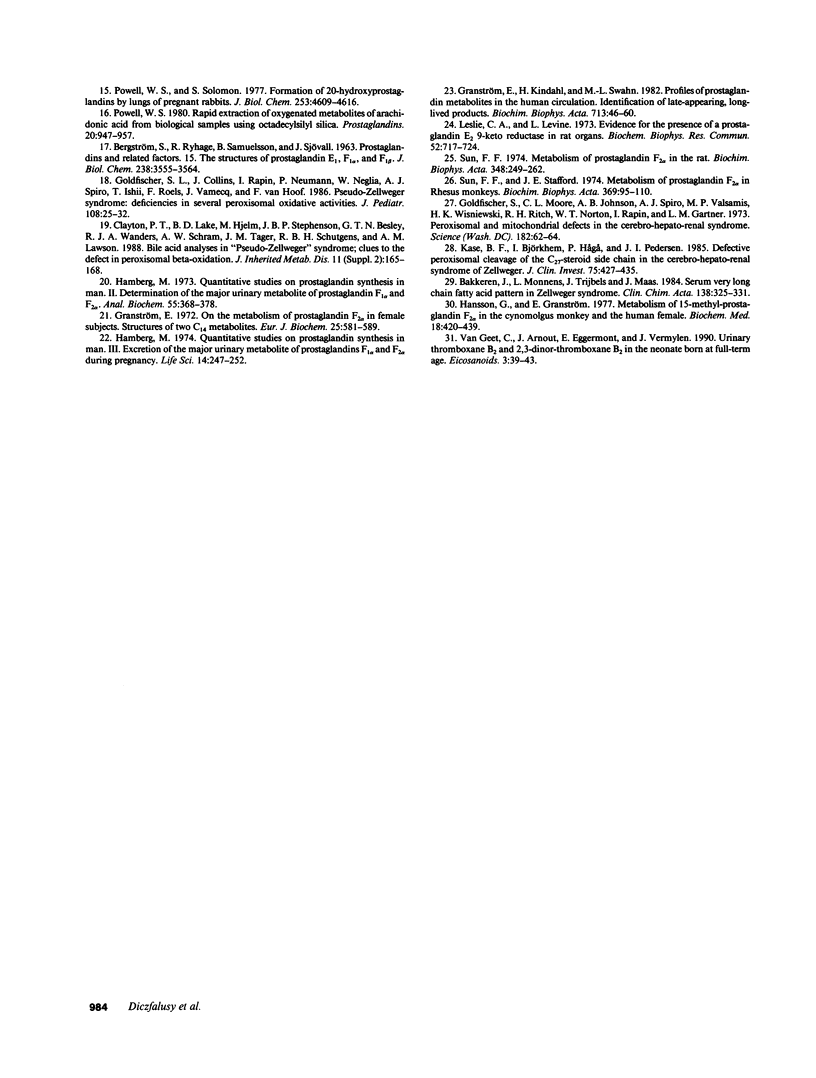Abstract
We have recently shown in vitro that the peroxisomal fraction of a rat liver homogenate has the highest capacity to beta-oxidize prostaglandins. In order to evaluate the relative importance of peroxisomes for this conversion also in vivo, we administered [3H]prostaglandin F2 alpha to an infant suffering from Zellweger syndrome, a congenital disorder characterized by the absence of intact peroxisomes. As a control, labeled compound was administered to two healthy volunteers. Urine was collected, fractionated on a SEP-PAK C18 cartridge, and subjected to reversed-phase high-performance liquid chromatography. The Zellweger patient was found to excrete prostaglandin metabolites considerably less polar than those of the control subjects. The major urinary metabolite in the control subjects was practically absent in the urine from the Zellweger patient. The major urinary prostaglandin F2 alpha metabolite from the Zellweger patient was identified as an omega-oxidized C20-prostaglandin, 9,11-dihydroxy-15-oxoprost-5-ene-1,20-dioic acid. The major urinary prostaglandin F2 alpha metabolite from the control subjects had chromatographic properties of a tetranor (C16) prostaglandin, in accordance with earlier published data. The present results, in combination with our previous in vitro data, indicate that peroxisomal beta-oxidation is of major importance for in vivo chain shortening of prostaglandins.
Full text
PDF






Selected References
These references are in PubMed. This may not be the complete list of references from this article.
- BERGSTROEM S., RYHAGE R., SAMUELSSON B., SJOEVALL J. PROSTAGLANDINS AND RELATED FACTORS. 15. THE STRUCTURES OF PROSTAGLANDIN E1, F1-ALPHA, AND F1-BETA. J Biol Chem. 1963 Nov;238:3555–3564. [PubMed] [Google Scholar]
- Bakkeren J. A., Monnens L. A., Trijbels J. M., Maas J. M. Serum very long chain fatty acid pattern in Zellweger syndrome. Clin Chim Acta. 1984 Apr 27;138(3):325–331. doi: 10.1016/0009-8981(84)90140-2. [DOI] [PubMed] [Google Scholar]
- Clayton P. T., Lake B. D., Hjelm M., Stephenson J. B., Besley G. T., Wanders R. J., Schram A. W., Tager J. M., Schutgens R. B., Lawson A. M. Bile acid analyses in "pseudo-Zellweger" syndrome; clues to the defect in peroxisomal beta-oxidation. J Inherit Metab Dis. 1988;11 (Suppl 2):165–168. doi: 10.1007/BF01804226. [DOI] [PubMed] [Google Scholar]
- Diczfalusy U., Alexson S. E., Pedersen J. I. Chain-shortening of prostaglandin F2 alpha by rat liver peroxisomes. Biochem Biophys Res Commun. 1987 May 14;144(3):1206–1213. doi: 10.1016/0006-291x(87)91439-2. [DOI] [PubMed] [Google Scholar]
- Diczfalusy U., Alexson S. E. Peroxisomal chain-shortening of prostaglandin F2 alpha. J Lipid Res. 1988 Dec;29(12):1629–1636. [PubMed] [Google Scholar]
- Goldfischer S., Collins J., Rapin I., Neumann P., Neglia W., Spiro A. J., Ishii T., Roels F., Vamecq J., Van Hoof F. Pseudo-Zellweger syndrome: deficiencies in several peroxisomal oxidative activities. J Pediatr. 1986 Jan;108(1):25–32. doi: 10.1016/s0022-3476(86)80764-8. [DOI] [PubMed] [Google Scholar]
- Goldfischer S., Moore C. L., Johnson A. B., Spiro A. J., Valsamis M. P., Wisniewski H. K., Ritch R. H., Norton W. T., Rapin I., Gartner L. M. Peroxisomal and mitochondrial defects in the cerebro-hepato-renal syndrome. Science. 1973 Oct 5;182(4107):62–64. doi: 10.1126/science.182.4107.62. [DOI] [PubMed] [Google Scholar]
- Granström E., Kindahl H., Swahn M. L. Profiles of prostaglandin metabolites in the human circulation. Identification of late-appearing, long-lived products. Biochim Biophys Acta. 1982 Oct 14;713(1):46–60. doi: 10.1016/0005-2760(82)90165-5. [DOI] [PubMed] [Google Scholar]
- Granström E. On the metabolism of prostaglandin F 2 in female subjects. Structures of two C 14 metabolites. Eur J Biochem. 1972 Feb;25(3):581–589. doi: 10.1111/j.1432-1033.1972.tb01731.x. [DOI] [PubMed] [Google Scholar]
- Granström E. On the metabolism of prostaglandin F 2 in female subjects. Structures of two metabolites in blood. Eur J Biochem. 1972 Jun 9;27(3):462–469. doi: 10.1111/j.1432-1033.1972.tb01861.x. [DOI] [PubMed] [Google Scholar]
- Granström E., Samuelsson B. On the metabolism of prostaglandin F 2 in female subjects. II. Structures of six metabolites. J Biol Chem. 1971 Dec 25;246(24):7470–7485. [PubMed] [Google Scholar]
- Granström E., Samuelsson B. On the metabolism of prostaglandin F-2-alpha in female subjects. J Biol Chem. 1971 Sep 10;246(17):5254–5263. [PubMed] [Google Scholar]
- Hamberg M. Metabolism of prostaglandins in rat liver mitochondria. Eur J Biochem. 1968 Oct 17;6(1):135–146. doi: 10.1111/j.1432-1033.1968.tb00430.x. [DOI] [PubMed] [Google Scholar]
- Hamberg M. Quantitative studies on prostaglandin synthesis in man. 3. Excretion of the major urinary metabolite of prostaglandins F 1 alpha and F 2 alpha during pregnancy. Life Sci. 1974 Jan 16;14(2):247–252. doi: 10.1016/0024-3205(74)90054-x. [DOI] [PubMed] [Google Scholar]
- Hamberg M. Quantitative studies on prostaglandin synthesis in man. II. Determination of the major urinary metabolite of prostaglandins F1 alpha and F2 alpha. Anal Biochem. 1973 Oct;55(2):368–378. doi: 10.1016/0003-2697(73)90125-5. [DOI] [PubMed] [Google Scholar]
- Hamberg M., Samuelsson B. On the metabolism of prostaglandins E 1 and E 2 in man. J Biol Chem. 1971 Nov 25;246(22):6713–6721. [PubMed] [Google Scholar]
- Hamberg M., Samuelsson B. The structure of the major urinary metabolite of prostaglandin E2 in man. J Am Chem Soc. 1969 Apr 9;91(8):2177–2178. doi: 10.1021/ja01036a092. [DOI] [PubMed] [Google Scholar]
- Hansson G., Granström E. Metabolism of 15-methyl-prostaglandin F2alpha in the cynomolgus monkey and the human female. Biochem Med. 1977 Dec;18(3):420–439. doi: 10.1016/0006-2944(77)90078-3. [DOI] [PubMed] [Google Scholar]
- Heikura S., Similä S., Finni K., Mäentausta O., Jänne O. Cholic acid and chenodeoxycholic acid concentrations in serum during infancy and childhood. Acta Paediatr Scand. 1980 Sep;69(5):659–662. doi: 10.1111/j.1651-2227.1980.tb07339.x. [DOI] [PubMed] [Google Scholar]
- Johnson M., Davison P., Ramwell P. W. Carnitine-dependent oxidation of prostaglandins. J Biol Chem. 1972 Sep 10;247(17):5656–5658. [PubMed] [Google Scholar]
- Kase B. F., Björkhem I., Hågå P., Pedersen J. I. Defective peroxisomal cleavage of the C27-steroid side chain in the cerebro-hepato-renal syndrome of Zellweger. J Clin Invest. 1985 Feb;75(2):427–435. doi: 10.1172/JCI111717. [DOI] [PMC free article] [PubMed] [Google Scholar]
- Kase B. F., Pedersen J. I., Strandvik B., Björkhem I. In vivo and vitro studies on formation of bile acids in patients with Zellweger syndrome. Evidence that peroxisomes are of importance in the normal biosynthesis of both cholic and chenodeoxycholic acid. J Clin Invest. 1985 Dec;76(6):2393–2402. doi: 10.1172/JCI112252. [DOI] [PMC free article] [PubMed] [Google Scholar]
- Leslie C. A., Levine L. Evidence for the presence of a prostaglandin E 2 -9-keto reductase in rat organs. Biochem Biophys Res Commun. 1973 Jun 8;52(3):717–724. doi: 10.1016/0006-291x(73)90996-0. [DOI] [PubMed] [Google Scholar]
- Powell W. S. Rapid extraction of oxygenated metabolites of arachidonic acid from biological samples using octadecylsilyl silica. Prostaglandins. 1980 Nov;20(5):947–957. doi: 10.1016/0090-6980(80)90144-6. [DOI] [PubMed] [Google Scholar]
- Powell W. S., Solomon S. Formation of 20-hydroxyprostaglandins by lungs of pregnant rabbits. J Biol Chem. 1978 Jul 10;253(13):4609–4616. [PubMed] [Google Scholar]
- Powell W. S. omega-Oxidation of prostaglandins by lung and liver microsomes. Changes in enzyme activity induced by pregnancy, pseudopregnancy, and progesterone treatment. J Biol Chem. 1978 Oct 10;253(19):6711–6716. [PubMed] [Google Scholar]
- Roscher A., Molzer B., Bernheimer H., Stöckler S., Mutz I., Paltauf F. The cerebrohepatorenal (Zellweger) syndrome: an improved method for the biochemical diagnosis and its potential value for prenatal detection. Pediatr Res. 1985 Sep;19(9):930–933. doi: 10.1203/00006450-198509000-00013. [DOI] [PubMed] [Google Scholar]
- Schepers L., Casteels M., Vamecq J., Parmentier G., Van Veldhoven P. P., Mannaerts G. P. Beta-oxidation of the carboxyl side chain of prostaglandin E2 in rat liver peroxisomes and mitochondria. J Biol Chem. 1988 Feb 25;263(6):2724–2731. [PubMed] [Google Scholar]
- Sun F. F. Metabolism of prostaglandin F2alpha in the rat. Biochim Biophys Acta. 1974 May 29;348(2):249–262. doi: 10.1016/0005-2760(74)90236-7. [DOI] [PubMed] [Google Scholar]
- Sun F. F., Stafford J. E. Metabolism of prostaglandin F2alpha in rhesus monkeys. Biochim Biophys Acta. 1974 Oct 16;369(1):95–110. doi: 10.1016/0005-2760(74)90196-9. [DOI] [PubMed] [Google Scholar]
- Van Geet C., Arnout J., Eggermont E., Vermylen J. Urinary thromboxane B2 and 2,3-dinor-thromboxane B2 in the neonate born at full-term age. Eicosanoids. 1990;3(1):39–43. [PubMed] [Google Scholar]


